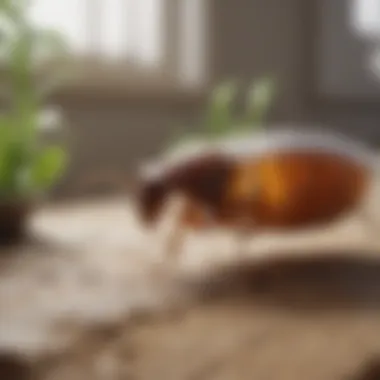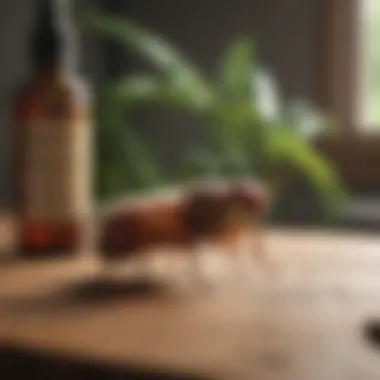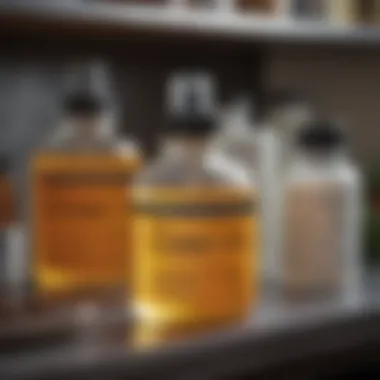Comprehensive Strategies for Eliminating Fleas in Your Home


Intro
Flea infestations can be a significant nuisance in any home. These pests not only irritate pets but can also affect the overall comfort of your living space. Fleas reproduce rapidly, making it essential for homeowners to act swiftly and effectively. Understanding the intricate life cycle of fleas is the first step in eradicating them. Without this knowledge, it’s easy to fall victim to temporary solutions that do not address the underlying issue. In this article, we will delve into comprehensive strategies for tackling flea infestations, using a mix of prevention, treatment, and ongoing maintenance practices that ensure a flea-free environment.
The subsequent sections of this article will cover unique methods for identification, elimination, and prevention of fleas. By addressing both existing problems and potential future infestations, homeowners will gain valuable insights into maintaining their spaces.
Understanding the Flea Life Cycle
Fleas go through four life stages: egg, larva, pupa, and adult. Knowing this cycle is crucial for implementing effective control measures.
- Egg: Fleas lay eggs in the fur of hosts, where they easily fall into carpets and bedding. Eggs are not visible to the naked eye and can accumulate unnoticed.
- Larva: Flea larvae emerge from eggs, feeding on organic debris in their environment. They prefer dark spaces, making areas like carpets ideal breeding grounds.
- Pupa: The pupal stage is a protective cocoon where fleas can remain dormant for extended periods. They can wait for the right conditions to emerge as adults.
- Adult: Adult fleas can jump up to 150 times their body length. They are the stage most commonly encountered by homeowners, as they feed on blood and can quickly cause discomfort to pets and humans.
Understanding this cycle can guide your approach to treatment and prevention.
Identifying Infested Areas
Before taking action, identifying where fleas are located is critical. Common areas to inspect include:
- Carpets and Rugs: Fleas thrive in dense fabrics. Look for flea droppings, which resemble small dark specks.
- Pet Bedding: Frequent areas where pets sleep are often hot spots for fleas.
- Couches and Upholstered Furniture: These are often overlooked. Use a flashlight to inspect hidden crevices.
- Yards and Gardens: Fleas can inhabit areas where pets frequent outside. Tall grass and shaded areas can harbor fleas.
Strategic Elimination Methods
Successful flea eradication requires a multi-faceted approach. Combine several techniques for the best results:
Natural Solutions
- Diatomaceous Earth: This natural powder can be sprinkled in infested areas. It kills fleas by dehydrating them.
- Essential Oils: Oils like lavender and eucalyptus can deter fleas. Be cautious, especially around pets.
- Salt: A common household item can dry out flea eggs. Spread salt on carpets and vacuum after a few hours.
Chemical Treatments
Sometimes, natural solutions may not suffice. When necessary, you can consider:
- Flea Sprays: Products containing pyrethroids can effectively kill adult fleas. Always follow label instructions.
- Foggers: These can cover large spaces but require careful preparation. Ensure people and pets are safely out of the area before use.
"The comprehensive strategy you choose should include both immediate and long-term treatments to manage flea populations."
Preventative Measures
After successfully eliminating fleas, focus on prevention to keep them from returning:
- Regular Cleaning: Vacuum floors and wash pet bedding weekly. Dispose of vacuum bags immediately.
- Pet Care: Use flea preventative treatments on pets. Consult with a veterinarian for product recommendations.
- Yard Maintenance: Maintain your yard by regularly mowing the grass and trimming plants to reduce flea habitats.
Long-Term Maintenance Practices
Continual vigilance and maintenance will secure a flea-free home. Consider implementing a regular schedule to check for fleas and reinforce preventative measures. By staying informed and proactive in your approach, you can create an environment that is unfriendly to fleas.
Understanding Fleas: An Overview
Fleas are small, wingless insects that are parasitic and feed on the blood of mammals and birds. Their presence can lead to significant discomfort and health issues for both pets and humans alike. Therefore, understanding fleas is essential for anyone looking to maintain a clean and healthy home. This overview will highlight critical elements such as identification, life cycles, and species types.
Identifying fleas is the first step in managing an infestation. Many homeowners may not recognize a flea problem until it becomes severe. They must not only identify adult fleas but also understand their larvae and eggs, which can be present in carpets, bedding, and pet areas.
The life cycle of a flea consists of several stages: egg, larva, pupa, and adult. Each stage has a specific duration and can thrive in various environments. An adult flea can lay thousands of eggs, making the potential for rapid population growth very high. Therefore, knowledge of this cycle helps in effective treatment strategies, as some methods target different developmental stages.
There are several common types of fleas; each has its unique characteristics and preferred hosts. For instance, the cat flea, Ctenocephalides felis, prefers domestic cats but also infests dogs and humans. Understanding the specific type can assist in selecting the best control measures.
Overall, providing insight into fleas and their behavior can enable homeowners to act decisively, deploying efficient strategies to mitigate infestations. This foundational knowledge serves as a crucial step toward maintaining a flea-free environment.


Recognizing Flea Infestation
Understanding the signs of a flea infestation is critical for homeowners to effectively combat these pests. Early recognition can prevent a minor issue from escalating into a major problem. Fleas multiply rapidly, and their presence can disrupt the household environment. Moreover, recognizing the infestation not only helps in taking immediate actions but also aids in identifying the various areas that require thorough treatment.
Symptoms of Infestation
Identifying symptoms of a flea infestation is the first necessary step. Here are some common signs:
- Itchy bites: Flea bites typically appear as small, red, and itchy spots. The bites usually occur around the ankles and legs but can affect other body parts as well.
- Visible fleas: Spotting fleas themselves is a good indicator. They are small, brownish creatures that move quickly. Adult fleas can jump up to 8 inches, making them hard to catch.
- Pet behavior changes: Pets may exhibit signs of discomfort like excessive scratching, biting at their fur, or restlessness. Observing these behaviors can indicate an infestation affecting your furry companions.
- Flea dirt: This is a mixture of flea feces and dried blood and appears as tiny black specks. If sprinkled on a wet paper towel, it turns red due to the digested blood.
It is essential to contact pest control or implement eradication measures as soon as signs become noticeable to prevent wider spread and ensure a healthy living space.
Common Hiding Spots
Fleas are adept at finding hiding spots in your home. Knowledge of these areas can aid in efficient eradication. Consider the following locations:
- Carpets and rugs: Fleas thrive in soft materials where they can easily hide. Vacuuming these areas is key to reducing their presence.
- Pet bedding: Fleas often congregate in the places where pets sleep and rest. Regular washing of pet bedding helps eliminate eggs and larvae.
- Furniture: Fleas can rest in the crevices of sofas, chairs, and other upholstered furniture. Their hiding ability means these areas require thorough vacuuming and inspection.
- Baseboards and corners: Unseen areas like baseboards and corners are often overlooked during cleaning. These spots can harbor developed fleas or their eggs, making them essential cleaning targets.
- Your garden: Outdoor areas like lawns or gardens can also act as flea breeding grounds. Regular maintenance here is imperative as well.
By identifying these hiding spots through diligent observation, homeowners can take timely action to reduce the flea population effectively. Taking advantage of these insights will enhance your ability to maintain a flea-free home.
Preventative Measures
Preventative measures form the bedrock of effective flea control. They help in minimizing the chances of an infestation and can reduce the reliance on chemical solutions. Implementing a strategic plan ensures that both the home environment and pets remain inhospitable to fleas. This section will examine various approaches, focusing on cleaning routines, outdoor strategies, and pet care practices. Understanding these methods assists homeowners in creating a comprehensive defense against fleas.
Regular Cleaning Routines
Vacuuming Techniques
Vacuuming is a critical element in flea prevention. Regular vacuuming removes fleas in various life stages, including eggs and larvae, from carpets and upholstery. The key characteristic is how thoroughly it picks up debris, making it a popular choice for maintaining cleanliness in any home. Vacuuming has unique features, such as the ability to reach tight spaces where fleas hide. An advantage is its effectiveness without the need for chemicals, making it safe for families and pets. However, it requires consistency; skipping even a week can allow flea populations to grow again.
Wash Pet Bedding
Washing pet bedding is another essential routine. Fleas thrive in warm and cozy environments, making bedding a prime location. This practice involves regular washing and drying at high temperatures. The distinctive benefit is that it not only removes fleas but also their eggs, thus breaking the cycle. Regularly washing pet bedding is beneficial because it minimizes reinfestation risks. The challenge can be that it may take time to establish a consistent washing schedule, but its long-term advantages are significant.
Outdoor Control Strategies
Managing Lawn and Garden
Managing the lawn and garden is a crucial outdoor strategy. Fleas can live in grassy and shaded areas outside the home. Keeping the lawn trimmed and removing debris reduces potential flea habitats. The key aspect here is maintaining an environment where fleas are less likely to thrive. It involves regular mowing and raking. This preventive measure is beneficial as it creates less opportunity for fleas to enter the home. However, it can be labor-intensive and may not provide immediate results.
Creating a Barrier
Creating a barrier around the home can act as an effective line of defense against fleas. This involves using natural repellents or physical barriers such as gravel or cedar chips. The primary characteristic is its preventive nature, as it stops fleas from getting close to your home. A significant advantage of this method is it can reduce the likelihood of fleas migrating from outdoor areas into indoor spaces. Nonetheless, the disadvantage may lie in the requirement for regular upkeep to ensure effectiveness.
Pet Care Practices
Regular Grooming
Regular grooming of pets is vital in flea prevention. This process includes brushing fur to detect fleas before they become a problem. The main characteristic is that grooming offers an immediate visual check for fleas, making it an effective and proactive measure. It is beneficial as it not only addresses flea presence but also promotes pet hygiene. One disadvantage is that it requires time, but it strengthens the bond between pet and owner.
Flea Preventative Products
Using flea preventative products is a proactive approach to flea management. These include topical treatments, sprays, and collars designed specifically to repel or eliminate fleas. The key aspect is their effectiveness in preventing infestations before they start. They are popular because they can provide long-lasting protection with relatively low effort. However, it is essential to choose the right product for each pet, as some may have adverse reactions. Proper guidance from a veterinarian ensures safety and maximum efficacy.
Chemical Solutions for Fleas
Addressing fleas in your home often requires more than simple cleaning methods. Chemical solutions play a critical role in effectively eliminating these pests. They offer a range of benefits that can significantly reduce or eliminate flea populations, particularly in severe infestations. However, it is essential to approach these options with informed caution. Chemical treatments can be powerful, yet they might pose risks for pets, children, and the environment if not used properly. Therefore, understanding each type of chemical solution available is vital.


Insect Growth Regulators
Insect Growth Regulators, or IGRs, prevent the development of fleas at various life cycle stages. As a result, they help in breaking the reproductive cycle of these pests. Unlike traditional insecticides that kill adult fleas, IGRs focus on inhibiting growth and maturation. This can be a strategic advantage since it targets future generations, thereby reducing the overall flea population over time.
One popular IGR is Methoprene, which mimics the natural hormones in insects. When fleas are exposed to this substance, their growth is stunted, preventing them from maturing into adults. Another common choice is Pyriproxyfen. This compound deforms developing fleas and prevents them from completing their life cycle.
Using IGRs can be particularly useful in conjunction with other methods. Instead of solely relying on contact insecticides, which may only provide a temporary solution, incorporating IGRs can ensure that fleas do not rebound once adult populations are eliminated.
Flea Sprays and Powders
Flea sprays and powders provide immediate relief and control of flea populations. Spray solutions are less complicated to use. These products typically contain active ingredients such as Pyrethrins and Permethrin. Both are effective for killing adult fleas on contact. When using flea sprays, it is crucial to follow application guidelines carefully.
- Pyrethrins: Derived from the chrysanthemum flower, Pyrethrins are fast-acting and primarily affect the nervous system of the flea.
- Permethrin: A synthetic version of Pyrethrin, Permethrin can provide longer-lasting protection.
As for powders, they are a useful option for applying in areas where fleas hide, like carpets and upholstery. These products generally contain ingredients like Diatomaceous Earth or other insecticides. Forward application tends to be a little messier than sprays, yet they can last longer if used appropriately.
Always ensure to keep pets and children away from treated areas until they are dry and safe to re-enter.
Professional Pest Control
When flea infestations reach a certain scale, seeking professional pest control is often warranted. Pest control experts can assess the situation thoroughly, applying specialized knowledge and equipment that is not typically available to homeowners. Their chemicals are often stronger and more effective, targeting various life cycle stages of fleas.
Professionals will usually employ a combination of methods. This may include using IGRs, insecticides, and even additional techniques like steam cleaning or fogging. Unlike DIY methods, their treatments are designed to penetrate deep into furnishings and cracks where fleas might hide.
For homeowners, engaging a service may seem more costly initially, but long-term effectiveness can justify this expense. With professionals, there is usually less guesswork and more guarantee of success. Additionally, some pest control services offer follow-up treatments to monitor and address potential reinfestations.
Using a combination of chemical solutions can create a multi-faceted approach to flea control. Understanding these options allows homeowners to customize their eradication plans, which can be beneficial for maintaining a flea-free environment.
Natural Remedies for Fleas
Natural remedies for fleas offer alternatives to chemical solutions. These methods are not only safer for the environment but also for your pets and family members. Many homeowners prefer natural solutions because they reduce exposure to harsh chemicals. Furthermore, some natural methods can be cost-effective and readily available in your household. Applying various natural remedies can significantly decrease flea populations and maintain a flea-free home in the long run.
Essential Oils
Essential oils are potent and concentrated liquids extracted from plants. They can repel and kill fleas effectively. Many homeowners are turning to these oils as a part of their flea control strategy. The key characteristic of essential oils is their natural ability to disrupt the life cycle of fleas and deter them from infesting areas.
Using Lavender Oil
Using lavender oil is an effective choice for flea control. It has a strong aroma that fleas find unpleasant. This oil is also known for its calming properties, making it popular in households. The unique feature of lavender oil is its dual functionality – it not only repels fleas but also creates a pleasant scent in your home. However, some may find concentrated lavender oil irritating to skin. Therefore, it’s crucial to dilute it before applying or use it in a diffuser.
Utilizing Lemongrass Oil
Utilizing lemongrass oil offers a refreshing solution to flea infestations. Its citrus scent serves as a deterrent against fleas and other pests. Lemongrass oil can be mixed with carrier oil for application or used in sprays. Its key characteristic is the natural compounds, which are effective in preventing fleas. On the downside, the smell might not be appealing to everyone. Pet owners should be cautious and ensure their pets do not ingest the oil directly.
Diatomaceous Earth
Diatomaceous earth is a powdery substance made from fossilized algae. Often used as an insecticide, it can effectively kill fleas without harming pets. The unique feature of diatomaceous earth is its ability to dehydrate fleas when they come in contact with it. Homeowners can sprinkle it on carpets, pet bedding, and other affected areas. This method is non-toxic, making it ideal for families. However, users must ensure they are using food-grade diatomaceous earth, as other types can be harmful.
Homemade Flea Traps
Homemade flea traps are a simple yet effective way to capture fleas. These traps can be made using household materials and are usually inexpensive, adding a practical aspect to flea control. The unique feature of homemade flea traps is their ability to allow homeowners to monitor flea populations easily.
Materials Needed
The materials needed for making flea traps are minimal. You will primarily need:
- Shallow dish or bowl
- Warm water
- Dish soap
- A light source


This approach is beneficial because it requires little investment and can be assembled in minutes. An advantage of homemade traps is that they can be positioned in strategic locations where fleas are suspected.
Setup Instructions
Setting up a flea trap involves a few simple steps. First, place the shallow dish filled with warm water and a few drops of dish soap. This mixture decreases the surface tension, causing fleas to drown when they jump in. Next, position the light source above the dish at night. Fleas are attracted to the light and will jump toward it. The simplicity of this method is its main advantage, making it accessible for all homeowners. However, it might not eliminate all fleas but assists in reducing the population.
"Natural remedies not only focus on immediate relief but also help maintain a long-term flea-free environment."
Maintaining a Flea-Free Home
Maintaining a flea-free home is essential for the comfort and health of both the residents and their pets. Fleas are not only a nuisance but can also cause skin irritations and allergies, particularly for animals. This section emphasizes the importance of ongoing efforts to prevent and eliminate flea populations in your household. Consistent practices can significantly reduce the likelihood of reinfestation.
Regular cleaning, continued pet treatments, and monitoring for potential reinfestation risks form the backbone of a robust strategy for maintaining a flea-free environment. Each of these elements contributes to a holistic approach, ensuring that fleas do not find a welcoming habitat in your living space.
Long-term Cleaning Strategies
A proactive cleaning routine is vital in any home, especially when dealing with pests like fleas. This includes routines beyond the typical once-a-week vacuum. Here are some facets to consider:
- Daily Sweeping or Vacuuming: Focus on high-traffic areas to collect flea eggs, larvae, and adults. Pay special attention to corners, under furniture, and where pets often rest.
- Deep Cleaning: Perform deep cleaning regularly. This may require professional services or specialized equipment. Consider steam cleaning carpets and upholstery, as heat can kill flea eggs.
- Use of Carpet Shampooers: Employ carpet shampooers that are designed to remove dirt while also targeting fleas. Look for products specifically formulated to assist in pest management.
Developing a consistent cleaning schedule will create an inhospitable environment for fleas.
Continued Pet Treatments
Flea treatments are not a one-time affair. Ongoing care for pets is crucial to keeping fleas at bay. Here are some recommended practices:
- Regular Use of Flea Medications: Use veterinarian-recommended flea treatments continuously during flea season. Products such as Frontline or Advantage can prevent adult fleas from developing on pets.
- Grooming: Frequent grooming with a flea comb will help find any existing fleas or eggs. This practice also removes dead hair and promotes a healthy coat.
- Regular Vet Visits: Ensure pets are checked during regular visits to your vet. They may suggest additional preventive measures tailored for your pet's specific needs.
Continued attention to pet health is instrumental in breaking the flea life cycle within your home.
Monitoring Reinfestation Risks
Awareness is key to maintaining a flea-free home. Recognizing signs of potential reinfestation can help you take action before a problem escalates. Keep an eye out for:
- Signs of Scratching: If pets are scratching more than usual, this may indicate the presence of fleas.
- Flea Dirt: Black specks on pet bedding or carpets can indicate flea feces, which is a sign of infestation.
- Home Environment: Check for potential flea-friendly environments in your home. Fleas thrive in areas with high humidity and pet activity.
Regularly monitoring your home and pets allows for quick responses to any signs of flea activity, reducing the chance of a full-blown infestation.
Flea management requires ongoing effort, not just an immediate fix. Consistency is key for long-term success.
Culmination: A Comprehensive Approach
In the battle against fleas, a thorough strategy is crucial. The awarenes of how fleas thrive and spread is vital for any homeowner. This article lays out multiple facets of flea control, blending preventative measures and treatment options to help ensure a flea-free environment.
After evaluating strategies, it becomes clear that inconsistency can lead to reinfestation. Regular maintenance eounting both cleaning and treatment is essential to breaking the flea life cycle. Moreover, understanding which methods work best in your living space can provide better results.
Effective eradication relies not only on immediate solutions but also on long-term practices. This will minimize the likelihood of fleas returning and allows for a more pleasant home.
"The key to a pest-free home is ongoing vigilance and adopting a multi-faceted strategy."
Summary of Key Points
The essential points highlighted throughout this guide include:
- Understanding the flea life cycle: Knowledge of every stage enables homeowners to target each effectively.
- Recognizing signs of infestation: Identifying where fleas reside allows for more efficient treatment.
- Adopting prevention methods: Regularly cleaning homes and treating pets can significantly reduce the risk of a flea outbreak.
- Utilizing both chemical and natural solutions: There are various products available, and choosing what suits your lifestyle is crucial.
- Implementing long-term strategies: Continuous monitoring and upkeep are necessary for lasting relief.
Final Recommendations
For successful flea elimination, consider the following recommendations:
- Establish a consistent cleaning schedule. Vacuum floors and furniture regularly to disrupt any flea habitats.
- Make use of a variety of flea control strategies. Don’t rely on just one solution, whether it is chemical or natural.
- Treat all pets with suitable flea prevention products. Ensure these treatments are applied on a regular basis to keep pets and homes safe.
- After addressing an infestation, keep close watch on your living space. Pay attention to potential resurgence and act quickly if fleas seem to return.
In summary, being proactive and thorough in your approach is the pathway to achieving a flea-free home.



